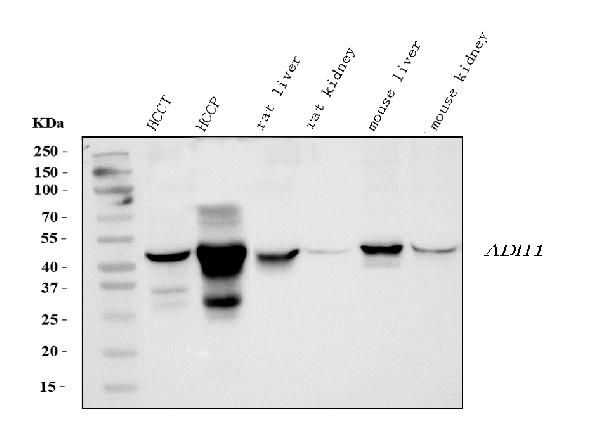
Figure 1. Western blot analysis of ADH1A using anti-ADH1A antibody (PB10029). Electrophoresis was performed on a 5-20% SDS-PAGE gel at 70V (Stacking gel) / 90V (Resolving gel) for 2-3 hours. The sample well of each lane was loaded with 30 ug of sample under reducing conditions. Lane 1: human HCCT tissue lysates, Lane 2: human HCCP tissue lysates, Lane 3: rat liver tissue lysates. Lane 4: rat kidney tissue lysates. Lane 5: mouse liver tissue lysates. Lane 6: mouse kidney tissue lysates. After electrophoresis, proteins were transferred to a nitrocellulose membrane at 150 mA for 50-90 minutes. Blocked the membrane with 5% non-fat milk/TBS for 1.5 hour at RT. The membrane was incubated with rabbit anti-ADH1A antigen affinity purified polyclonal antibody (Catalog # PB10029) at 0.5 microg/mL overnight at 4°C, then washed with TBS-0.1%Tween 3 times with 5 minutes each and probed with a goat anti-rabbit IgG-HRP secondary antibody at a dilution of 1:5000 for 1.5 hour at RT. The signal is developed using an Enhanced Chemiluminescent detection (ECL) kit (Catalog # EK1002) with Tanon 5200 system. A specific band was detected for ADH1A at approximately 40 kDa. The expected band size for ADH1A is at 40 kDa.
Anti-Alcohol Dehydrogenase/ADH1A Antibody Picoband(r)

PB10029
ApplicationsFlow Cytometry, ImmunoFluorescence, Western Blot, ImmunoCytoChemistry, ImmunoHistoChemistry
Product group Antibodies
ReactivityHuman, Mouse, Rat
TargetADH1A
Overview
- SupplierBoster Bio
- Product NameAnti-ADH1A Picoband Antibody
- Delivery Days Customer9
- Antibody SpecificityNo cross reactivity with other proteins.
- Application Supplier NoteTested Species: In-house tested species with positive results. By Heat: Boiling the paraffin sections in 10mM citrate buffer, pH6.0, for 20mins is required for the staining of formalin/paraffin sections. Other applications have not been tested. Optimal dilutions should be determined by end users.
- ApplicationsFlow Cytometry, ImmunoFluorescence, Western Blot, ImmunoCytoChemistry, ImmunoHistoChemistry
- CertificationResearch Use Only
- ClonalityPolyclonal
- Concentration500 ug/ml
- FormulationLyophilized
- Gene ID124
- Target nameADH1A
- Target descriptionalcohol dehydrogenase 1A (class I), alpha polypeptide
- Target synonymsADH, alpha subunit; ADH1; alcohol dehydrogenase 1 (class I), alpha polypeptide; alcohol dehydrogenase 1A; alcohol dehydrogenase subunit alpha; aldehyde reductase
- HostRabbit
- IsotypeIgG
- Protein IDP07327
- Protein NameAlcohol dehydrogenase 1A
- Scientific DescriptionBoster Bio Anti-Alcohol Dehydrogenase/ADH1A Antibody Picoband® catalog # PB10029. Tested in Flow Cytometry, IF, IHC, ICC, WB applications. This antibody reacts with Human, Mouse, Rat. The brand Picoband indicates this is a premium antibody that guarantees superior quality, high affinity, and strong signals with minimal background in Western blot applications. Only our best-performing antibodies are designated as Picoband, ensuring unmatched performance.
- ReactivityHuman, Mouse, Rat
- Storage Instruction-20°C,2°C to 8°C
- UNSPSC12352203





